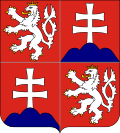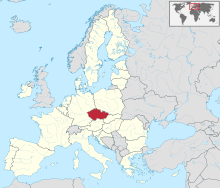Czech and Slovak Federal Republic
| Česká a Slovenská Federativní Republika (Czech) Česká a Slovenská Federatívna Republika (Slovak) |
|||||
| Czech and Slovak Federal Republic | |||||
| 1990-1992 | |||||
|
|||||
|
Motto : The truth wins! ( Latin Veritas vincit ) |
|||||
| Official language | Czech and Slovak | ||||
| Capital | Prague | ||||
| Form of government | Federal Republic | ||||
| Government system | Parliamentary democracy | ||||
| Head of state |
President : Václav Havel |
||||
| Head of government |
Prime Minister : Marián Čalfa (1989–1992) Jan Stráský (1992) |
||||
| surface | 127.900 km² | ||||
| population | 15.7 million (1991) | ||||
| currency | Czechoslovak crown | ||||
| founding | March 29, 1990 as the Czechoslovak Federal Republic , renamed the Czech and Slovak Federal Republic on April 23, 1990 | ||||
| resolution | December 31, 1992 | ||||
| National anthem | Kde domov můj and Nad Tatrou sa blýska | ||||
| Location and territory of Czechoslovakia 1992. | |||||
The Czech and Slovak Federal Republic ( Czech Česká a Slovenská Federativní Republika , Slovak Česká a Slovenská Federatívna Republika , short form ČSFR ) was a federal state that emerged from the Velvet Revolution . The federation consisted of the Czech Republic and Slovakia and represents the last historical period in Czechoslovakia , in which democracy was restored in the communist state since 1948. When the federation was founded on March 29, 1990, it was briefly called the Czechoslovak Federal Republic ( Czech Československá federativní republika , Slovak Česko-slovenská federatívna republika ), after the so-called dash dispute it was renamed on April 22, 1990.
history
Velvet revolution
In 1989, the renewal movement in the Eastern Bloc , made possible by Mikhail Gorbachev's reform program and the so-called Sinatra Doctrine of the Soviet Union, also took hold in Czechoslovakia. The first demonstrations took place on November 16 in Bratislava . After large demonstrations on the following day on Wenceslas Square in Prague , which could no longer be prevented even by brutal police operations, the presidium and the secretariat of the Communist Party resigned on November 24, 1989. Shortly before, 12 opposition groups had come together to form the “ Citizens' Forum ”. Now the collapse of the regime took place at a rapid pace: the leadership role of the Communist Party was deleted from the constitution, a largely non-communist cabinet under the reform communist Marián Čalfa took over the affairs of state, and President Husák resigned. On December 28th was Alexander Dubcek , the representative of the Prague Spring of 1968, elected President of the Federal Assembly, and a day later he swore in the newly elected civil Vaclav Havel as the first non-Communist president since 1948 and the Federative Republic was proclaimed, the word "socialist" from the State names deleted. The Velvet Revolution , a peaceful and non-violent uprising of the people, was complete and the Communist Party regime overthrown. In the next few months, the first steps were taken to establish free democratic conditions and to introduce a market economy.
Name dispute
After long arguments in which national differences between Czechs and Slovaks became apparent, the Federal Assembly decided on the state name Czech and Slovak Federal Republic (ČSFR). In the first free parliamentary elections on June 8 and 9, 1990, the Czech "Citizens' Forum" and the Slovak sister party " Public Against Violence " ( Verejnosť proti násiliu ) won an absolute majority in the Federal Assembly. Havel was confirmed in office for 2 years, and Čalfa (who had converted to “Public Against Violence”) was again charged with forming a government. The privatization of the economy has started.
The name was adopted by the so-called Constitutional Act, which allowed the name of the Czechoslovak Federal Republic to be changed into the Czech and Slovak Federal Republic, on April 23, 1990 the name was officially adopted. However, since it was not possible to agree on a uniform spelling for the short form (see " Dash War "), the name Czechoslovakia (Czech: Československo ) was used in the Czech part of the country and the name Czecho-Slovakia (Slovak: Česko-Slovensko ) used:
- Czech: Česká a Slovenská Federativní Republika (Československo)
- Slovak: Česká a Slovenská Federatívna Republika (Česko-Slovensko)
Disarmament and division of the army
As the economy was bad, the Czechoslovak Army was disarmed and the apparatus, which originally consisted of 200,000 soldiers, was reduced to 180,000 soldiers. On December 25, 1992, the army was divided into the Armed Forces of the Czech Republic and the Armed Forces of the Slovak Republic .
Division and end of Czechoslovakia
In 1992, large parts of the public political elite of the Czech Republic and Slovakia (particularly well represented in this role: Václav Klaus and Vladimír Mečiar ) pushed ahead with the dissolution of the state union, which continued until the end of President Václav Havel and the leader of the Slovak Christian Democrats , Ján Čarnogurský, was defended. The many problems in business and other areas called for a quick solution to the problem. For example, on November 25, 1992, the Federal Assembly passed a law on the division of the state, which dissolved the Czech and Slovak Federal Republic on December 31, 1992. On January 1, 1993, the two successor states were constituted: the Czech Republic and Slovakia.
Popular reactions to the partition of Czechoslovakia
Shortly before the division, around 60% of the country's population was against the division of Czechoslovakia.
- Czech Republic: 65% against division
- Slovakia: 55% against division
In 2002 the company ODS carried out another survey of the two countries, the results were now:
- Czech Republic: 60% against division
- Slovakia: 32% against division
See also
literature
- Constitutional Law No. 81/1990 Coll. To change the name of the Czechoslovak Socialist Republic
- Constitutional Law No. 101/1990 Coll. To change the name of the Czechoslovak Federal Republic
Individual evidence
- ↑ http://wissen.spiegel.de/wissen/dokument/dokument.html?top=Ref&dokname=BERTEL_LEX-tid-1799255&suchbegriff=CSSR&titel=Tschechoslowakei ( page no longer available , search in web archives ) Info: The link was automatically defective marked. Please check the link according to the instructions and then remove this notice.
- ↑ See Maya Hertig: The Dissolution of Czechoslovakia. Analysis of a peaceful state division. Helbing & Lichtenhahn, Basel et al. 2001, ISBN 3-7190-2075-4 ( review by H-Soz-Kult ). Media reports on Radio Praha , MDR , Die Presse , WDR and Zeit Online .




